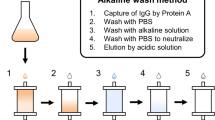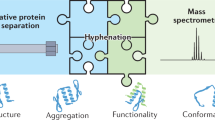Abstract
Rapid growth in the preparative and high-resolution analytical applications of metal-affinity chromatography demonstrate the appeal of metal recognition as a basis for protein separations. Stable, inexpensive chelated metals effectively mimic bio-specific interactions, providing selective ligands for protein binding. This article reviews recent progress in understanding the mechanisms of metal-protein recognition that underlie metal-affinity separations. Also discussed are schemes for integrating metal-affinity purifications into the expression and bioprocessing of re-combinant proteins. Promising future developments include new metal-affinity processes for analytical and preparative-scale separations and a range of techniques for enhancing the selectivity of metal-affinity separations.
This is a preview of subscription content, access via your institution
Access options
Subscribe to this journal
Receive 12 print issues and online access
$209.00 per year
only $17.42 per issue
Buy this article
- Purchase on Springer Link
- Instant access to full article PDF
Prices may be subject to local taxes which are calculated during checkout
Similar content being viewed by others
References
Davankov, V.A., Semechkin, A.V. 1977. Ligand-exchange chromatography. J. Chromatogr. 141: 313–353.
Porath, J., Carlsson, J., Olsson, I. and Belfrage, G. 1975. Metal chelate affinity chromatography, a new approach to protein fractionation. Nature 258: 598–599.
Vijayalakshmi, M.A. 1989. Pseudobiospecific ligand affinity chromatography. Trends Biotechnol. 7 : 71–76.
Maisano, F., Testpro, S.A. and Grandi, G. 1989. Immobilized metal-ion affinity chromatography of human growth hormone. J. Chromatogr. 472: 422–427.
Furlong, A.M., Thomsen, D.R., Marotti, K.R., Post, L.E. and Sharma, S.K. 1988. Active human tissue plasminogen activator secreted from insect cells using a baculovirus vector. Biotech. and Appl. Biochem. 10: 454–464.
Zawistowska, U., Sangster, K., Zawistowski, J., Langstaff, J. and Friesen, A.D. 1988. Immobilized metal affinity chromatography of wheat α-amylases. Cereal Chemistry 65: 413–416.
Corradini, D., Rassi, Z.E., Horvath, C., Guerra, G. and Horne, W. 1988. Combined lectin-affinity and metal-interaction chromatography for the separation of glycophorins by high-performance liquid chromatography. J. Chromatogr. 458: 1–11.
Botros, H.G. and Vijayalakshmi, M. 1989. Cell surface interactions with metal chelates. J. Chromatogr. 495: 113–122.
Sulkowski, F. 1989. The saga of IMAC and MIT. BioEssays 10: 169–175.
Yip, T.-T., Nakagawa, Y. and Porath, J. 1989. Evaluation of the interaction of peptides with Cu(II), Ni(II), and Zn(II) by high-performance immobilized metal ion affinity chromatography. Anal. Biochem. 183: 159–171.
Chaga, G., Andersson, L., Ersson, B. and Porath, J. 1989. Purification of two mucle enzymes chromatography on immobilized ferric ions. Biotechnol. Appl. Biochem. 11: 424–431.
Hemdan, E.S., Zhao, Y., Sulkowski, E. and Porath, J. 1989. Surface topography of histidine residues: a facile probe by immobilized metal ion affinity chromatography. Proc. Natl. Acad. Sci., USA. 86: 1811–1815.
Todd, R., Van Dam, M., Casimiro, D., Haymore, B.L. and Arnold, F.H. 1990. Cu(II)-binding properties of a synthetic metal-binding cytochrome c: His-X3-His in an α-Helix. Submitted.
Suh, S.-S. and Arnold, F.H. 1990. A mathematical model for metal affinity partitioning. Biotechnol. & Bioeng. 35: 682–690.
Leporati, E. 1986. Formation and stability of ternary complexes of copper(II) with ethylenediamine-N-acetic acid and amino acids in aqueous solution. J. Chem. Soc. Dalton Trans. 199–203.
Suh, S.-S., Haymore, B.L. and Arnold, F.H. 1990. Characterization of His-X3-His sites in α-helices of synthetic metal-binding bovine somatotropin. Protein Engineering. In press.
Sulkowski, E. 1985. Purification of proteins by IMAC. Trends Biotechnol. 3: 1–7.
Sulkowski, E. 1987. Immobilized metal ion affinity chromatography of proteins, p. 149–162. In: Protein Purification: Micro to Macro. R. Burgess (Ed.) A. R. Liss, Inc., NY.
Haymore, B.L., Bild, G.S., Abdel-Meguid, S.S., Clare, M.C., Krivi, G.G., Salsgiver, W.J. and Staten, N.R. Introducing strong metal-binding sites into somatotropin. Facile and efficient metal-affinity purification. Submitted.
Sundberg, R.J., Martin, R.B. 1974. Interactions of histidine and other imidazole derivatives with transition metal ions in chemical and biological systems. Chem. Rev. 74: 471–517.
Smith, M.C., Furman, T.C. and Pidgeon, C. 1987. Immobilized iminodiacetic acid metal peptide complexes. Identification of chelating peptide purification handles for recombinant proteins. Inorg. Chem. 26: 1965–1969.
Porath, J. and Olin, B. 1983. Immobilized metal ion affinity absorption and immobilized metal ion affinity chromatography of biomaterials. Serum protein affinities for gel-immobilized iron and nickel ions. Biochemistry. 22: 1621–1630.
Hochuli, E., Dobeli, H. & Schacher, A. 1987. New metal chelate adsorbent selective for proteins and peptides containing neighboring histidine residues. J. Chromatogr. 411: 177–184.
Porath, J. 1988. IMAC—immobilized metal ion affinity based chromatography. Trends Anal. Chem. 7: 254–259.
Skerra, A., Pfitzinger, I. and Pluckthun, A. 1991. The functional expression of antibody Fv fragments in E. coli: improved vectors and a generally applicable purification technique. Bio/Technology. In press.
Wuenschell, G.E., Wen, E. and Arnold, F.H. 1990. Chiral copper-chelate complexes alter selectivities in metal-affinity partitioning. Submitted.
Porath, J. 1987. Metal ion—hydrophobic, thiophilic and II-electron governed interactions and their application to salt-promoted protein adsorption chromatography. Biotech. Progr. 3: 14–21.
Figueroa, A., Corradini, C., Feibush, B. and Karger, B.L. 1986. High-performance immobilized-metal affinity chromatography of proteins on iminodiacetic acid silica-based bonded phases. J. Chromatogr. 371: 335–352.
El Rassi, Z. and Horvath, Cs. 1986. Metal chelate-interaction chromatography of proteins with iminodiacetic acid-bonded stationary phases on silica support. J Chromatogr. 359: 241–253.
Uhlen, M. and Miks, T. 1990. Gene fusions for purpose of expression: an introduction. Methods Enzymol. 185: 129–143.
Klapper, M.H. 1977. The independent distribution of amino acid near neighbor pairs into polypeptides. Biochem. Biophys. Res. Comm. 78: 1018–1024.
Smith, M.C., Furman, T.C., Ingolia, T.D. and Pidgeon, C. 1988. Chelating peptide-immobilized metal ion affinity chromatography. J. Biol. Chem. 263: 7211–7215.
Hochuli, E., Bannwarth, W., Dobeli, H., Gentz, R. and Stuber, D. 1988. Genetic approach to facilitate purification of recombinant proteins with a novel metal chelate absorbent. Bio/Technology 6: 1321–1325.
LeGrice, S.F.J., Gruninger-Leitch, F. 1990. Rapid purification of homodimer and heterodimer HIV-1 reverse transcriptase by metal chelate affinity chromatography. Eur. J. Biochem. 187: 307–314.
Ljungquist, C., Breitholtz, A., Brink-Nilsson, H., Moks, T., Uhlen, M. and Nilsson, B. 1989. Immobilization and affinity purification of recombinant proteins using histidine peptide fusions. Eur. J. Biochem. 186: 563–569.
Wuenschell, G.E., Naranjo, E. and Arnold, F.H. 1990. Aqueous two-phase metal affinity extraction of heme proteins. Bioprocess Engineering 5: 199–202.
Plunkett, S. and Arnold, F.H. 1990. Metal affinity extraction of human hemoglobin in an aqueous polyethylene glycol/sodium sulfate two-phase system. Biotechnology Techniques 4: 45–48.
Van Dam, M.E., Wuenschell, G.E. and Arnold, F.H. 1989. Metal affinity precipitation of proteins. Biotechnol. Appl. Biochem. 11: 492–502.
Stover, F.S., Haymore, B.L. and McBeath, R.J. 1989. Capillary zone electrophoresis of histidine-containing compounds. J. Chromatogr. 470: 241–250.
Hutchens, T.W., Li, C.M., Sato, Y. and Yip, T.-T. 1989. Multiple DNA-binding receptor forms resolved by interaction with immobilized metal ions. J. Biol. Chem. 264: 17206–17212.
Author information
Authors and Affiliations
Rights and permissions
About this article
Cite this article
Arnold, F. Metal-Affinity Separations: A New Dimension in Protein Processing. Nat Biotechnol 9, 151–156 (1991). https://doi.org/10.1038/nbt0291-151
Issue Date:
DOI: https://doi.org/10.1038/nbt0291-151
This article is cited by
-
Immobilized CotA Laccase for Efficient Recovery of HEAVY OIL
Waste and Biomass Valorization (2023)
-
Differences between Cu- and Fe–Cu nanoflowers in their interactions with fluorescent probes ANS and Fura-2 and proteins albumin and thrombin
Polymer Bulletin (2022)
-
First protein affinity application of Cu2+-bound pure inorganic nanoflowers
Polymer Bulletin (2022)
-
Pumice particle interface: a case study for immunoglobulin G purification
Polymer Bulletin (2021)
-
Multifunctional and biodegradable self-propelled protein motors
Nature Communications (2019)



